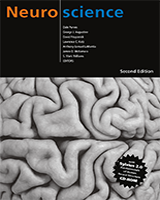By agreement with the publisher, this book is accessible by the search feature, but cannot be browsed.
NCBI Bookshelf. A service of the National Library of Medicine, National Institutes of Health.
Purves D, Augustine GJ, Fitzpatrick D, et al., editors. Neuroscience. 2nd edition. Sunderland (MA): Sinauer Associates; 2001.

Neuroscience. 2nd edition.
Show detailsSoon after neural tube formation, the forerunners of the major brain regions become apparent as a result of morphogenetic movements that bend, fold, and constrict the neural tube. Initially, the anterior end of the tube forms a crook, giving it the shape of a cane handle (Figure 22.4A). The end of the cane nearest the sharper bend, or cephalic flexure, balloons out to form the forebrain, or prosencephalon. The midbrain, or mesencephalon, forms as a bulge called the cephalic flexure. The hindbrain, or rhombencephalon, forms in the long, relatively straight stretch between the cephalic flexure and the more caudal cervical flexure. Caudal to the cervical flexure, the neural tube forms the precursor of the spinal cord. This bending and folding constricts or enlarges the lumen enclosed by the developing neural tube. These lumenal spaces eventually become the ventricles of the mature brain (Figure 22.4B).

Figure 22.4
Regional specification of the developing brain. (A) Early in gestation the neural tube becomes subdivided into the prosencephalon (at the anterior end of the embryo), mesencephalon, and rhombencephalon. The spinal cord differentiates from the more posterior (more...)
Once the primitive brain regions are established in this way, they undergo at least two more rounds of partitioning, each of which produces additional regions in the adult (Figure 22.4C). Thus, the lateral aspects of the rostral prosencephalon forms the telencephalon. The two bilaterally symmetric telencephalic vesicles contain the rudiments of the cerebral cortex, hippocampus, basal ganglia, basal forebrain nuclei, and olfactory bulb. The more caudal portion of the prosencephalon forms the diencephalon, which contains the rudiments of the thalamus and hypothalamus, as well as a pair of lateral outpocketings (the optic cups) from which the neural portion of the retina will form. The rostral part of the rhombencephalon becomes the metencephalon and gives rise to the adult cerebellum and pons. Finally, the caudal part of the rhombencephalon becomes the myelencephalon and gives rise to the adult medulla.
How can a simple tube of neuronal precursor cells produce such a variety of brain structures? At least part of the answer comes from the observation made early in the twentieth century that much of the neural tube is organized into repeating units called neuromeres. This discovery led to the idea that the process of segmentation—used by all animal embryos at the earliest stages of development to establish regional identity in the body—might also establish regional identity in the developing brain. Enthusiasm for this hypothesis was stimulated by observations of the development of the body plan of the fruit fly Drosophila. In the fly, early expression of a class of genes called homeobox genes (Box B) guides the differentiation of the embryo into distinct segments that give rise to the head, thorax, and abdomen (Figure 22.5). These genes code for DNA-binding proteins that can modulate the expression of other genes. Similar homeobox genes in mammals (referred to as Hox genes) have been identified. In some cases their patterns of expression coincide with, or even precede, the formation of morphological features such as the various bends, folds, and constrictions that signify the progressive regionalization of the developing neural tube, particularly in the hindbrain and spinal cord (Box C). More recently, similar genes have been associated with regional differentiation in the brainstem. The patterned expression of homeobox genes, as well as other developmentally regulated transcription factors and signaling molecules, does not by itself determine the fate of a group of embryonic neural precursors. As in the case of neural induction, regionally distinct transcription factor expression contributes to a series of genetic and cellular processes that eventually produce a fully differentiated brain.
Box B
Homeotic Genes and Human Brain Development.

Figure 22.5
Sequential gene expression divides the Drosophila melanogaster (fruit fly) embryo into regions and segments. (A) Temporal pattern of expression of four genes that influence the establishment of the body plan in Drosophila. A series of sections through (more...)
Box C
Rhombomeres.
- Formation of the Major Brain Subdivisions - NeuroscienceFormation of the Major Brain Subdivisions - Neuroscience
- Profile neighbors for GEO Profiles (Select 131949560) (199)GEO Profiles
Your browsing activity is empty.
Activity recording is turned off.
See more...